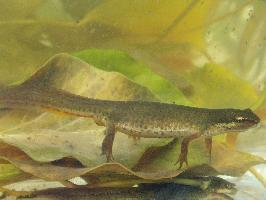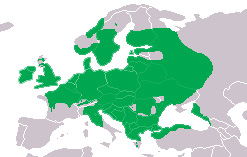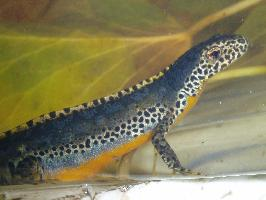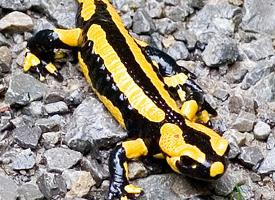
Greutăți și măsuri
| Lungime | de la 6 la 10 cm |
|---|
Descrierea animalului
The Smooth Newt, scientifically known as Lissotriton vulgaris, is a fascinating species of salamander found widely across Europe and parts of Asia. This amphibian is well-known for its remarkable adaptability and has been a subject of interest among herpetologists and nature enthusiasts alike.Adult Smooth Newts typically measure between 8 to 11 centimeters in length, with males being slightly larger and more vibrantly colored than their female counterparts, especially during the breeding season. They possess slender bodies covered in smooth, moist skin that varies in color from a pale brown or olive green to a more striking orange or brownish-yellow. A distinctive feature of the Smooth Newt is its belly, which is brightly colored with a pattern of spots, serving as a warning to predators about its mildly toxic nature.
One of the most captivating aspects of the Smooth Newt is its reproductive behavior and lifecycle, which is intricately linked to both aquatic and terrestrial habitats. Breeding takes place in spring when newts return to water bodies after spending the winter in terrestrial environments. Males display an elaborate courtship dance to attract females, involving a series of movements and the wafting of pheromones towards potential mates. After mating, the female lays her eggs individually on aquatic plants, carefully folding leaves around them for protection.
The eggs hatch into larvae after about two to three weeks, depending on the temperature of the water. These larvae are fully aquatic and possess external gills, a laterally flattened tail for swimming, and a carnivorous diet, feeding on small invertebrates. The larval stage lasts for about three months, after which the larvae undergo metamorphosis, losing their gills and developing lungs to breathe air as they transition to life on land.
As juveniles and adults, Smooth Newts are primarily terrestrial, only returning to water to breed. They are nocturnal creatures, spending their days hidden under rocks, logs, or dense vegetation to maintain their moist skin and avoid predators. Their diet shifts to include a wider variety of invertebrates, such as worms, slugs, and insects.
Despite their adaptability, Smooth Newts, like many amphibians, face threats from habitat destruction, pollution, and the introduction of invasive species. However, they are still relatively common and widespread, thanks in part to their ability to inhabit a variety of environments, including gardens and agricultural lands, where they can find suitable breeding ponds and terrestrial habitats.
In conclusion, the Smooth Newt is a remarkable creature that plays a crucial role in the ecosystems it inhabits. Its life cycle and behaviors offer a glimpse into the complexity and beauty of amphibian life, highlighting the importance of preserving their natural habitats for future generations to study and admire.
Harta răspândirii

Animale similare
Fotografii noi cu animale
Top 10 animale
- Dolphin gull (Leucophaeus scoresbii)
- Diana monkey (Cercopithecus diana)
- Moustached guenon (Cercopithecus cephus)
- Galápagos tortoise (Geochelone nigra complex)
- Stone loach (Barbatula barbatula)
- Greek tortoise (Testudo graeca)
- Japanese macaque (Macaca fuscata)
- Russian tortoise (Testudo horsfieldii)
- Common flying dragon (Draco volans)
- Galápagos penguin (Spheniscus mendiculus)


